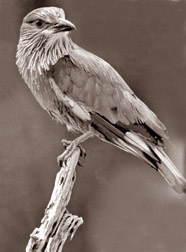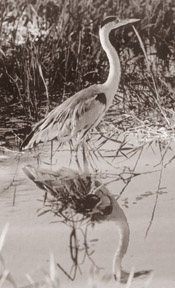|
observer |
|
|
|
|
|
OTHER LINKS |

|

|

|
Wildlife - Wilpattu National Park
Elephant (Elephas maximus) herds and lone males come to slake their thirst and cool off in the welcoming waters. They can be seen here even in the middle of the day. So too can the imposing figure of a water buffalo bull (Bubalus bubalis), half immersed and languid from long hours of inactivity. A small herd of spotted or axis deer (Axis axis), might appear, shy and skittish, flanks quivering as they brave the dangerous exposure to greet their wide-eyed reflections in the shimmering water. Any unexpected movement on the part of an observer or even the capricious play of the wind in the trees can send the wary herd fleeing back to the forest, thirsts unquenched. Stately sambhur (Cervus unicolour), wild boar (Sus scrofa) and bounding troops of grey langurs (Semnopithicus entellus therstes) also visit the villus to drink, while in the dappled light that filters through the lofty forest a lucky visitor might sight the shaggy and shambling figure of a sloth bear, head bowed as he snuffles through the leaf litter toward a termite mound. Of course, the villus are nothing without the myriad birds, both resident and migratory, that flock to gorge on the rich aquatic life. Painted (Myceteria leucocephala) and open bill (Anastomus oscitans) stocks breed here in numbers, while whistling teal (Dendrocygna javannica), black-headed ibis (Threskiornis melanocephalus), Eurasian spoonbills (Platakea leucordia) and egret remain throughout the year. The winter months see the arrival of garganey (Anas querequedula), Sopt-billed (Anas poecilorhyncha) and Northern pintail (Anas acuta) ducks, particularly in the littoral zone. In the late 1960s Wilpattu was the site of an extensive Smithsonian Institution large mammal survey with the central villus - Demata, Kalli, Kanjuran, Kokkare, Kumbuk, Mena, Nelun, Pannikar, Thala - as the focal region. Originally the park was one of many areas in the country chosen as part of a wide-ranging elephant census, but the abundant wildlife and excellent viewing opportunities encouraged the team of researchers to extend the scope of their work.
On another occasion we were fortunate enough, while the park was still closed, to get army permission to walk along the old road that runs from the Kala Oya at Illuvankulam on the southern boundary of the park, up through the forest to Pomarippu. It was a cautious trek as the muddy areas were rampant with the unmistakable impressions of elephants' massive feet, but spoor of lesser creatures was almost non-existent. We heard the sharp reports of poachers' guns several times and returned to our camp disillusioned at the apparent scale of the devastation, in this border region at least. However, the forest and her inhabitants are nothing if not resilient, and despite the illicit logging that has plundered some of the rare and precious tree species, the forest has survived and the fauna within can therefore recover. Already visitors are being treated to more and better sightings as the animals once again become habituated to the relatively benign presence of rattling jeeps and excited tourists, and adjust as the resounding creak of gunfire is replaced with the gentle click of a shutter release. Camping within the park can be arranged from the Wilpattu head office while the exquisitely designed A-frame Kokmotai circuit bungalow can now be booked from the Wildlife Department head office on Gergory's Road in Colombo. The re-opening of the park has meant the re-establishment of a Wildlife Department presence and hopefully continued visitation will mean an increase in effective protection of this stunningly beautiful and exceedingly important National Park. Wilpattu deserves more than to live on only in the wistful memories of the past and must be allowed to awaken new dreams and stir fresh longings for the magnificent diversity of the dry zone forests of Sri Lanka. Travel Sri Lanka |
 Parking on the villu's edge and patiently waiting as the sun's
scorching rays slowly concede their vigour is a favoured method of
viewing wildlife at Wilpattu. These freshwater lakes inevitably draw the
wild denizens of the immediate forests to drink, to bathe or to feed on
the young grasses that fringe the waters as they recede.
Parking on the villu's edge and patiently waiting as the sun's
scorching rays slowly concede their vigour is a favoured method of
viewing wildlife at Wilpattu. These freshwater lakes inevitably draw the
wild denizens of the immediate forests to drink, to bathe or to feed on
the young grasses that fringe the waters as they recede.  Today the animals within the park remain inhibited by the long
seclusion of the war years when any human visitors to the interior of
the park were army soldiers, LTTE cadres, poachers or illegal timber
cutters, all of whom needed to be avoided. Evidence of the dangers that
these groups posed came in the form of the decaying remains of a sloth
bear that we encountered, a T56 shell beside the bleaching bones, on an
army sanctioned visit to the park as it was being de-mined well prior to
opening.
Today the animals within the park remain inhibited by the long
seclusion of the war years when any human visitors to the interior of
the park were army soldiers, LTTE cadres, poachers or illegal timber
cutters, all of whom needed to be avoided. Evidence of the dangers that
these groups posed came in the form of the decaying remains of a sloth
bear that we encountered, a T56 shell beside the bleaching bones, on an
army sanctioned visit to the park as it was being de-mined well prior to
opening. 







